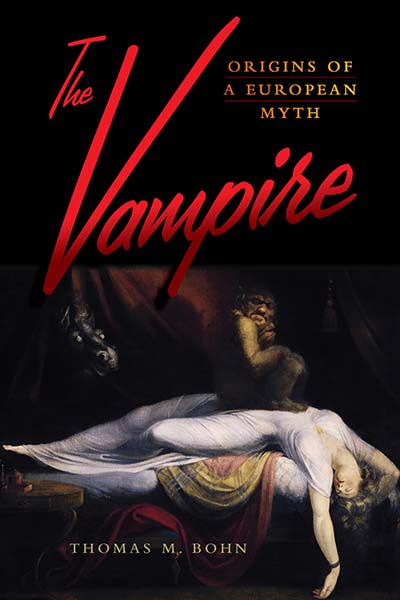
Email Newsletters
Sign up for our email newsletters to get customized updates on new Berghahn publications.
The Vampire
Origins of a European Myth
Thomas M. Bohn
Translated from the German by Francis Ipgrave
304 pages, 24 illus., bibliog., index
ISBN 978-1-78920-292-2 $135.00/£104.00 / Hb / Published (September 2019)
ISBN 978-1-80073-433-3 $34.95/£27.95 / Pb / Published (April 2022)
eISBN 978-1-83695-653-2 eBook
Reviews
“Thomas M. Bohn’s book on the ‘historical’ vampire is the rare epitome of a knowledgeable, critical and non-speculative monograph on the subject matter; it is not popular non-fiction, but still a very readable piece of academic writing… a splendid study.” • Journal of Vampire Studies
“One of the major contributions of Bohn’s study is his meticulous historiography of vampirism in eastern Europe…Weaving together historical analysis with the process of Christianization, The Vampire: Origins of a European Myth offers an illuminating contribution to scholarship on the vampire figure.” • Slavic Review
“Bohn's broad and diligently compiled study ranges from the legends of medieval Iceland, through early modern Silesia and Poland, and up to the modern-day Balkans… The author has tackled an important issue of pan-European relevance.” • Sehepunkte
Description
Even before Bram Stoker immortalized Transylvania as the homeland of his fictional Count Dracula, the figure of the vampire was inextricably tied to Eastern Europe in the popular imagination.
Drawing on a wealth of previously neglected sources, this book offers a fascinating account of how vampires—whose various incarnations originally emerged from folk traditions from all over the world—became so strongly identified with Eastern Europe. It demonstrates that the modern conception of the vampire was born in the crucible of the Enlightenment, embodying a mysterious, Eastern otherness that stood opposed to Western rationality.
From the Prologue:
From Original Sin to Eternal Life
For a broad contemporary public, the vampire has become a star, a media sensation from Hollywood. Bestselling authors such as Bram Stoker, Anne Rice and Stephenie Meyer continue to fire the imaginations of young and old alike, and bloodsuckers have achieved immortality through films like Dracula, Interview with a Vampireand Twilight. It is no wonder that, in the teenage bedrooms of our globalized world, vampires even steal the show from Harry Potter. They have long since been assigned individual personalities and treated with sympathy. They may possess superhuman powers, but they are also burdened by their immortality and have to learn to come to terms with their craving for blood. Whereas the Southeast European vampire, discovered in the 1730s, underwent an Americanization and domestication in the media landscape of the twentieth century, the creole zombies that first became known through the cheap novels and horror films of the 1920s still continue to serve as brainless horror figures. Do bloodsuckers really exist and should we really be afraid of the dead? These are the questions that I seek to tackle, following the wishes of my daughter, who was ten when I started this project.
Thomas M. Bohn is Professor of Russian and Soviet History at Justus Liebig University Giessen.
Subject: SociologyLiterary StudiesHistory (General)Cultural Studies (General)
Area: Central/Eastern Europe
Contents
Download ToC (PDF)



